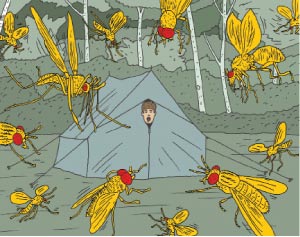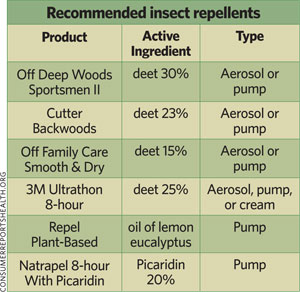
Are They Biting?
Not fish. Bugs. Here's how to prepare for the inevitable attack.
By Cliff Jacobson
Illustrations by Peter Arkle
WHEN I WAS A SCOUT in the 1950s, an experienced woodsman spoke to our troop about canoeing the Boundary Waters of Minnesota. When it came to bugs, he removed his jacket to reveal a T-shirt that bore a chest-filling likeness of a female mosquito and the words, "Minnesota State Bird."
 |
"This here's a small one," he said, pointing to the "bird." "I've seen some as large as bulldogs, so you boys best watch out!" I was barely 12, and I believed every word. As I got older, I learned that canoes and mosquitoes do go together. It's the price one pays for the fun of being outdoors. But I also discovered that biting insects are tolerable if you're well prepared.
Know Your Enemies
Mosquitoes swarm at dawn and dusk and just before an approaching storm. Lightweight long johns or a gentle breeze stops them cold. Horse flies and deer flies (those "bulldogs") attack on hot, sunny days—calm or windy. They bite through thin clothing and produce painful wounds that can become infected.
Black flies, which are the size of rice grains, breed in moving water. The larvae form dark-brown "nets" that look like nylon hose in the water. Don't camp near these. Black flies prefer confined areas around wrists, ankles, and ears. They can't fly in wind (any wind) or bite through thin clothing or long underwear. Unlike mosquitoes, black flies won't bite when confined inside a tent. Instead, they just climb to the roof and try to get out. Wait until they mass then crush them by the thousands with your bandanna. "No-see-ums" are smaller than the holes in mosquito netting. Their bite—a sharp, painful sting—subsides quickly.
Chemical Solutions
Almost any commercial repellent will, at a minimum, deter mosquitoes and no-see-ums—for a while. But only those that contain "deet" (chemical name, N,N-diethyl-meta-toluamide) work well for biting flies.
 |
The Centers for Disease Control and Prevention and the U.S. Army recommend 30 percent deet for problem bugs. My own experience in the Canadian Arctic suggests that's enough for all but the meanest black flies.
Although government tests conclude that deet does not cause health problems, adults with sensitive skin and all children should use a mild, cream-based (low-deet or no-deet) repellent or a "controlled-release" formula that uses submicron encapsulation. Here, a patented skin-nourishing protein builds walls around the deet molecules and encapsulates them. The capsules keep the deet away from your skin. The chemical is released slowly as the skin metabolizes the protein. Submicron encapsulation works for mosquitoes but not black flies.
Perhaps the safest plan with conventional repellents is to first rub sunblock into your skin, wait 10 minutes, then apply repellent. The sunblock keeps you from absorbing too much of the chemical.
People with super-sensitive skin should nix the bug juice and just wear long-sleeved shirts and trousers that have been sprayed with Permethrin. Permethrin is a low-toxic (to mammals) pesticide that kills bugs on contact. Spray it on clothing and tent screens, not skin. One application lasts up to two weeks, and the pesticide won't wash off with water.
Caution: Don't spray Permethrin on head nets or body nets—you don't want to breathe this stuff.
Head and Body Nets
A head net is a blessing when bugs are bad. Choose a black-colored net (for visual clarity) that rolls to fist size. Use a black, felt-tip marker to darken the eye panel of light-colored nets and make your vision much clearer.
After the Bite
Benadryl dulls the pain of bug bites, as do products that contain at least 80 percent aloe. AfterBite and similar topical products contain natural ingredients such as eucalyptus oil and Vitamin E that will help control itching and swelling. For stings, apply a wet salt pack and let it dry.
Cliff Jacobson, a Distinguished Eagle Scout, is the author of more than a dozen top-selling outdoors books.